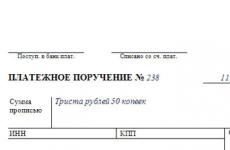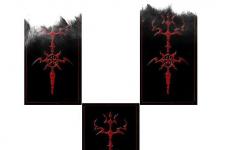Correct LED activation. Serial or parallel connection of LEDs? How to connect LEDs in parallel in series
Let's consider ways to connect medium-power ice diodes to the most popular ratings of 5V, 12 volts, 220V. Then they can be used in the manufacture of color and music devices, signal level indicators, smooth start and shutdown. I’ve been planning to make a smooth artificial dawn for a long time in order to maintain my daily routine. In addition, dawn emulation allows you to wake up much better and easier.
Drivers with power supply from 5V to 30V

If you have a suitable power source from any household appliances, then it is better to use a low-voltage driver to turn it on. They can be up or down. A booster will make even 1.5V 5V so that the LED circuit works. A step-down from 10V-30V will make a lower one, for example 15V.
They are sold in a large variety by the Chinese; the low-voltage driver differs in two regulators from a simple Volt stabilizer.
The actual power of such a stabilizer will be lower than what the Chinese indicated. In the module parameters, they write the characteristics of the microcircuit and not the entire structure. If there is a large radiator, then such a module will handle 70% - 80% of what was promised. If there is no radiator, then 25% - 35%.

Particularly popular are models based on LM2596, which are already quite outdated due to low efficiency. They also get very hot, so without a cooling system they do not hold more than 1 Ampere.
XL4015, XL4005 are more efficient, the efficiency is much higher. Without a cooling radiator, they can withstand up to 2.5A. There are very miniature models based on MP1584 measuring 22mm by 17mm.
Turn on 1 diode

The most commonly used are 12 volts, 220 volts and 5V. This is how low-power LED lighting of 220V wall switches is made. Factory standard switches most often have a neon lamp installed.
Parallel connection

When connecting in parallel, it is advisable to use a separate resistor for each serial circuit of diodes in order to obtain maximum reliability. Another option is to put one powerful resistor on several LEDs. But if one LED fails, the current on the remaining ones will increase. By whole it will be higher than the nominal or specified value, which will significantly reduce the resource and increase heating.
The rationality of using each method is calculated based on the requirements for the product.
Serial connection

Serial connection when powered from 220V is used in filament diodes and LED strips at 220 volts. In a long chain of 60-70 LEDs, each drops 3V, which allows you to connect directly to high voltage. Additionally, only a current rectifier is used to obtain plus and minus.
This connection is used in any lighting technology:
- LED lamps for home;
- led lamps;
- New Year's garlands for 220V;
- LED strips 220.
Lamps for the home usually use up to 20 LEDs connected in series; the voltage across them is about 60V. The maximum quantity is used in Chinese corn light bulbs, from 30 to 120 LED pieces. Corns do not have a protective flask, so the electrical contacts on which up to 180V are completely open.
Be careful if you see a long series string, and they are not always grounded. My neighbor grabbed the corn with bare hands and then recited fascinating poems from bad words.
RGB LED connection

Low-power three-color RGB LEDs consist of three independent crystals located in one housing. If 3 crystals (red, green, blue) are turned on simultaneously, we get white light.
Each color is controlled independently of the others using an RGB controller. The control unit has ready-made programs and manual modes.
Turning on COB diodes

The connection diagrams are the same as for single-chip and three-color LEDs SMD5050, SMD 5630, SMD 5730. The only difference is that instead of 1 diode, a series circuit of several crystals is included.
Powerful LED matrices contain many crystals connected in series and in parallel. Therefore, power is required from 9 to 40 volts, depending on the power.
Connecting SMD5050 for 3 crystals

The SMD5050 differs from conventional diodes in that it consists of 3 white light crystals, and therefore has 6 legs. That is, it is equal to three SMD2835 made on the same crystals.
At parallel connection Using a single resistor will reduce reliability. If one of the crystals fails, the current through the remaining 2 increases. This leads to accelerated burnout of the remaining ones.
By using a separate resistance for each crystal, the above disadvantage is eliminated. But at the same time, the number of resistors used increases by 3 times and the LED connection circuit becomes more complex. Therefore, it is not used in LED strips and lamps.

LED strip 12V SMD5630

A clear example of connecting an LED to 12 volts is an LED strip. It consists of sections of 3 diodes and 1 resistor connected in series. Therefore, it can only be cut in the indicated places between these sections.

LED strip RGB 12V SMD5050

RGB tape uses three colors, each is controlled separately, and a resistor is installed for each color. You can cut only at the indicated location, so that each section has 3 SMD5050 and can be connected to 12 volts.

Today, LEDs are manufactured in various wattages. A wide variety of power supplies are suitable for them. It should also be taken into account that the connection of the model depends on the type of device driver (if any). Nowadays, you can find good and bad LED switching schemes. To understand this issue in more detail, you need to look at models of different capacities.
Connection to 5 V network
In a 5 V network, the LEDs (diagram shown below) are most often connected in series order. IN in this case Much depends on the nominal resistance in the network. If this parameter exceeds 10 Ohms, then it is more advisable to use switching power supplies.
At the same time, a pass-through capacitor will help cope with electromagnetic interference in the circuit. In this case, it is better to connect LEDs with linear resistors. In turn, open analogues can withstand a maximum resistance of 13 Ohms. To increase the conductivity of the LED, system modulators are used.
If we consider models with contact drivers, then controllers must be selected separately for them. Most often they are used with a special amplifier. In this case, the threshold voltage will be at 6 V. In order to solve the problem with negative polarity in the network, many experts recommend using operational amplifiers.
Connection to 12 V network
Connecting LEDs to 12 volts can be done either in series or in parallel. If we consider the first option, then it is more advisable to select switching type power supplies. You should also know that you can connect LEDs to 12 volts without amplifiers. However, if more than three pieces are installed, then they must be provided. Models with resonant drivers should only be connected to low-impedance amplifiers.
If we consider parallel connection of LEDs, then in this case it is important to select two open resistors for the circuit. In this case, the first of them must be installed in front of the amplifier. Bandwidth its current must be no lower than 3 A. At the same time, the threshold voltage parameter in the device should not be allowed below the level of 4 A. As a rule, the negative resistance of models of this type is small. At the same time, maintaining linearity is achieved through the use of high-quality drivers.

LEDs in 220 V network
What features does connecting LEDs have in this case? 220V usually provides for a sequential order. Power supplies in this case are mainly used of the step-down type. To prevent an increase in frequency, connecting LEDs to a 220V network must be done with operational amplifiers.
It should also be taken into account that their sensitivity depends on the types of filters. In order to minimize magnetic interference, experts advise installing low-impedance filters. In this case, a lot depends on the LED driver. If we consider the analog type, then it will require a rotary regulator. To cope with nonlinear distortions in this situation, low-frequency adapters are used. They are usually installed near amplifiers.

Diagram of connecting devices to a computer
LEDs can be connected to a computer in different ways. As a rule, capacitors for this purpose are used only of the phase type. In this case, open resistors can be used, but they must withstand a threshold voltage of at least 5 V. Additionally, you should pay attention to the frequency of the LED.
If we consider standard models, they are connected to power supplies through amplifiers. In this case, resistors must be located at the end of the circuit. If we consider high-power LEDs, then they will require an integrated amplifier. In this case, drivers with high coverage are welcome. The conductivity of the device depends solely on the power of the power supply. In this case, the direct connection of the LED occurs through a surge protector.
Connection to low frequency power supply
Connecting LEDs to the low-frequency power supply (diagram shown below) can only be done in a network with DC. In this case, resistors are used of the open type. In this case, the minimum power of the LED must be 5 V. An amplifier for it can be selected as an operational type. If we consider models with drivers, they are often soldered together with feed-through capacitors.
In this case, the conductivity parameter is closely related to their capacitance. To enhance the sensitivity of the device, many experts advise using broadband converters. In this case, adapters for combating interference are not suitable. However, it makes sense to install different filters. Additionally, it should be noted that the regulators in the circuit can be used of both rotary and push-button types.

Connecting LEDs to a high-frequency power supply
LEDs are connected to high-frequency power supplies only through an auxiliary adapter. In this case, the type of driver plays an important role. If we consider single-pole models, they are distinguished by a high conductivity parameter. In this case, the negative resistance in the circuit should be kept at 10 ohms. If only one LED is connected, then an operational amplifier is not necessary.
Otherwise, it is better to install it to solve nonlinear distortion problems. Additionally, it should be taken into account that electrode drivers are not suitable for connection to high-frequency power supplies. This is primarily due to the high sensitivity of such devices. In this situation, the LEDs will burn out quite quickly. In this case, power regulators will not help.
Serial connection
The LEDs are connected in series using zener diodes. Finding them in stores today is quite easy. They are usually installed on a special magnetic grid. To fix them on the board you will have to use a blowtorch. It should also be taken into account that the power supply must have powerful amplifier. In this case, many experts recommend installing resistors of the pectron type.
At the same time, they must withstand a nominal resistance level of at least 4 ohms. In turn, the load parameter is welcomed at around 20 A. The problem with magnetic interference can be solved by installing an output filter. To increase the sensitivity of the device, both variable and static capacitors are used. They differ quite a lot in size. In this regard, this issue must be approached individually each time.

Circuits with capacitive capacitors
Connection powerful LEDs With capacitive capacitors, at first glance, it is quite simple. However, in this situation, it is necessary to first take into account the power of the resistors. It is also important to remember that the parameters of LED drivers can vary quite a lot. In this regard, it is necessary to select capacitors for the device very carefully. First of all, the power supply directly to which the amplifier is connected is evaluated. If we consider modifications with a threshold voltage of 20 V, then in this case one capacitor can be used.
Otherwise, two of them are installed to solve problems with nonlinear distortion. In turn, the sensitivity of the device can always be adjusted using the controller. The drivers themselves are most often used of the pulse type. In turn, various modulators can be installed. Problems with polarity should not arise in this case. As a result, with a 20 V power supply, the threshold current must be maintained at 3 A. In this case, the frequency may fluctuate depending on voltage surges in the network.

Using snubber capacitors
Connecting LEDs with damping capacitors requires the use of 15 V power supplies. In this case, resistors are used only of the open type. As a result, the negative resistance parameter in the circuit does not exceed 30 Ohms. Please also note that LEDs can only be used low power. The capacitors are installed directly near the power supplies. In this case for normal operation Amplifier devices are not required.
Due to the high sensitivity of the models, their threshold voltage is at least 15 V. Moreover, the maximum load depends on the power of the LEDs. Drivers for models are usually selected of the latitudinal type. Solving the problem with negative polarity in such a situation can be quite simple. Filters for this purpose should be installed behind amplifiers. Also in this case, integral tetrodes will help solve the problem.
Application of absorption filters
Filters of this type are most suitable for 20 V LEDs. Moreover, with pulse blocks they are not able to work with power supply. Additionally, it should be taken into account that they do not solve problems with nonlinear distortions. In turn, filters can stabilize frequency quite quickly. Due to this, problems with sensitivity in such models are very rare.

LEDs with wave receivers
LEDs of this type are usually connected directly to power supplies. In this case, amplifiers in the network are not required. However, in this case it is important to remember the type of resistor. If it is used open, filters will have to be installed. Additionally, it should be taken into account that these receivers are ideal for serial connection of LEDs. In this case, parallel connection can provoke nonlinear distortions. The sensitivity of the device will depend on the input voltage parameter.
LEDs with magnetic drivers
LEDs with magnetic drivers are usually connected in series order. At the first stage, it is very important to evaluate their power. Additionally, the negative resistance parameter in the circuit should be taken into account. If we consider low-power models, they are connected to power supplies through an amplifier. Otherwise, it is better to use surge protectors.
In this case, absorption modifications can lead to magnetic interference. How to solve problems with increased frequency in this case? Experts recommend using single-channel resistors. In this case, you can select a wide variety of modulators for the circuit.

In the diagram we see a traditional series connection of LEDs connected to a battery.
This connection requires the LEDs to glow equally brightly. But here the resistor “interferes” with us.
Let's look at a slightly different example. Namely, let's take an LED driver and connect it to three serial LEDs.
As a result of the fact that the current strength in the closed circuit is the same, then the same current I 1 =I 2 =I 3 will flow through each diode. A connection without a resistor using a driver also ensures the same brightness, and the difference in voltage drop across the diodes does not matter meanings. It is reflected only in the magnitude of the potential difference between points 1 and 2.

Calculation of a driver for serial connection of LEDs
The above daisy chain connection of LEDs may cause big questions regarding the choice of the driver itself. Using the calculation algorithm below, you can always calculate the driver yourself, depending on the selected connection.
Let's say we need to power three LEDs connected in series with a current of 700 mA.
The voltage drop (fictitious) at this current is 3.2 to 3.4 V.
Minimum voltage U min =3*3.2=9.6 V
Maximum voltage U max =3.4*3=10.2 V
The power consumed by the LEDs will be: P=10.2*0.7=7.14 W.
Total: our driver must have:
Output current 700 mA
Output voltage 10.2V +- 5%
Output power no less than 7.2 W
This is all! As you can see. no problem. I will not consider calculating the resistor in the absence of a driver. These are relics of the past. Any manufacturer already produces led drivers for every taste and color. Moreover, their cost is negligible. And the efficiency of the “box” is much greater than that of a simple resistor.
Pros and cons of daisy chaining LEDs
There is one big plus - cheapness in design.
There are at least two disadvantages to a serial connection:
- If at least one LED fails, the entire chain will naturally go out. Here, however, you can find another plus... If the diode short-circuits, the circuit will not break and the rest of the chips will continue to work.
- If there are a lot of LEDs, then low-voltage power supply is extremely difficult to implement. And this is already a problem. Especially if you need to have safety first.
Video on serial connection of LEDs
For those who are too lazy to read a lot of books, we suggest watching a simple video on the topic: “serial connection of LEDs.” From it you will quickly gain information on how to correctly connect diodes with such a connection.
Electrical installation components are special products that ensure the uninterrupted functioning of electrical systems. Such elements are widely used in industrial enterprises when laying, repairing and pulling cables, as well as when connecting electrical equipment. Well-known manufacturers Hensel, Mennekes, Weidmueller, Wieland manufacture products in accordance with the basic requirements of European quality and safety standards.
Types of electrical installation components
The Indatek LLC company presents a wide range of products for installing electrical systems at the enterprise. Copper is used as a material for the manufacture of conductive products, and ceramic or porcelain mixtures are used for insulating products. In other cases, metal alloys with a protective coating of zinc or nickel are used.
Products for installing electrical systems are characterized by resistance to water, corrosion, and sudden temperature changes. Such elements meet safety standards and are harmless to humans. During the production process, products are tested for quality using a free-falling weight weighing 0.25 kg. Plugs, extension sockets, switches are additionally tested against a drop of 0.5 m in rotating drums.
Electrical installation components are divided into groups depending on:
– degrees of strength - products that can withstand the impact of a load falling from a height of 15 cm, 25 cm and 50 cm;
– type of connection - external, which are mounted on the surface of the structure, and built-in, which require a special niche.
– temperature resistance - products that can withstand heating up to + 80, + 100, + 130, + 160, + 240 degrees.
Terminals
Wieland terminals are used for connecting wires and cables various types. Construction - withstand a load of 10–100 A and a voltage of 600 V. Barrier terminals are more resistant, operating under a voltage of 1 kV and a load of up to 200 A. Products with spring and screw such as models WT 2.5 or WKF 1.5 D2/2/35 BLAU, fixation provides a stronger wire clamp.
Branch boxes and enclosures
The products are used when installing electrical systems and connecting several devices to one energy source. Such products provide high-quality grounding, conversion, and distribution of electricity throughout the entire system. The main material for production is polycarbonate. The German company Hensel is considered a popular manufacturer, whose products are presented in the online store indatech.ru.
Power connectors
Products are devices used to connect electrical equipment to the power grid. Sockets and plugs are recommended for use when working with powerful equipment in high humidity rooms and other unfavorable conditions.
Signal Concentrators (SAI)
Signal concentrators (SAIs), such as SAISW-3/7 sockets and SAIL-M12GM12W-4-2L3.0T connectors, are required for the normal operation of automation systems. Products are divided into active and passive buses, as well as power wires and connectors. Such products can be designed to work in extreme conditions: products with IP67 protection can withstand exposure to water and harmful substances. Some SAI concentrators are used for explosive applications.
Quite often we have to face this question - how to connect LEDs to 220 V, or simply to electrical network alternating voltage. As such, directly connecting the diode directly to the network does not carry any meaning. Even when using certain schemes, we will not get the desired effect.
If we need to connect an LED to a constant voltage network, then this problem can be solved very simply - we install a limiting resistor and forget about it. The LED worked in the forward direction and will continue to work.
If we need to use a 220 V network for LED connections, then it will already be affected by reverse polarity. This can be clearly seen by looking at the graph of a sinusoid, where each half-cycle of the sinusoid tends to change its sign to the opposite one. 
In this case, we will not get a glow in this half-cycle. In principle, it’s okay))), but the LED will fail very quickly.
In general, the quenching resistor should be chosen based on the design voltage condition of 310 V. Explaining why this is so is a tedious task, but it’s worth just remembering this, because The effective voltage value is 220 V, and the amplitude already increases by the root of two from the effective value. Those. this way we get the applied forward and reverse voltage to the LED. The resistor is selected at 310V of reverse polarity in order to protect the LED. We will see below how protection can be carried out.
How to connect LEDs to 220 V using a simple circuit using resistors and a diode - option 1
The first circuit operates on the principle of reverse half-cycle cancellation. The vast majority of semiconductors are negative about reverse voltage. To block it we need a diode. As a rule, in most cases diodes of the IN4004 type are used, designed for voltages greater than 300 V. 
Connecting LED using a simple circuit with a resistor and diode - option 2
Another simple circuit shows how to connect LEDs to 220 V AC voltage is not much more complicated and can also be classified as a simple circuit. 
Let's consider the principle of operation. With a positive half-wave, the current flows through resistors 1 and 2, as well as the LED itself. In this case, it is worth remembering that the voltage drop across the LED will be the opposite for a conventional diode - VD1. As soon as the negative half-wave of 220 V “gets” into the circuit, the current will flow through a regular diode and resistors. In this case, the direct voltage drop across VD1 will be opposite to the LED. It's simple.
With a positive half-wave of the mains voltage, current flows through resistors R1, R2 and LED HL1 (in this case, the forward voltage drop across LED HL1 is the reverse voltage for diode VD1). With a negative half-wave of the mains voltage, current flows through diode VD1 and resistors R1, R2 (in this case, the forward voltage drop across diode VD1 is the reverse voltage for LED HL1).
Calculation part of the scheme
Rated mains voltage:
U S.NOM = 220 V
The minimum and maximum network voltage is accepted (experienced data):
U S.MIN = 170 V
U C.MAX = 250 V
The HL1 LED with the maximum permissible current is accepted for installation:
I HL1.DOP = 20 mA
Maximum calculated peak current of LED HL1:
I HL1.AMP.MAX = 0.7*I HL1.ADP = 0.7*20 = 14 mA
Voltage drop across LED HL1 (experienced data):
Minimum and maximum effective voltage on resistors R1, R2:
U R.RMS.MIN = U S.MIN = 170 V
U R.RMS.MAX = U C.MAX = 250 V
Calculated equivalent resistance of resistors R1, R2:
R EQ.CALC = U R.AMP.MAX /I HL1.AMP.MAX = 350/14 = 25 kOhm
P R.MAX = U R.RMS.MAX 2 /R EQ.CALC = 2502/25 = 2500 mW = 2.5 W
Estimated total power of resistors R1, R2:
P R.CALC = P R.MAX /0.7 = 2.5/0.7 = 3.6 W
A parallel connection of two MLT-2 type resistors having a total maximum permissible power is accepted:
P R.ADOP = 2 2 = 4 W
Calculated resistance of each resistor:
R CALC = 2*R EQ.CALC = 2*25 = 50 kOhm
The nearest higher standard resistance of each resistor is taken:
R1 = R2 = 51 kOhm
Equivalent resistance of resistors R1, R2:
R EKV = R1/2 = 51/2 = 26 kOhm
Maximum total power of resistors R1, R2:
P R.MAX = U R.RMS.MAX 2 /R EQ = 2502/26 = 2400 mW = 2.4 W
Minimum and maximum peak current of LED HL1 and diode VD1:
I HL1.AMP.MIN = I VD1.AMP.MIN = U R.AMP.MIN /R EQ = 240/26 = 9.2 mA
I HL1.AMP.MAX = I VD1.AMP.MAX = U R.AMP.MAX /R EQ = 350/26 = 13 mA
Minimum and maximum average current of LED HL1 and diode VD1:
I HL1.AVG.MIN = I VD1.AVG.MIN = I HL1.ACTIVE.MIN /K F = 3.3/1.1 = 3.0 mA
I HL1.SR.MAX = I VD1.SR.MAX = I HL1.ACTIVE MAX /K F = 4.8/1.1 = 4.4 mA
Diode reverse voltage VD1:
U VD1.REV = U HL1.PR = 2 V
Design parameters of diode VD1:
U VD1.CALC = U VD1.REV /0.7 = 2/0.7 = 2.9 V
I VD1.CALC = U VD1.AMP.MAX /0.7 = 13/0.7 = 19 mA
A VD1 diode of type D9V is accepted, which has the following basic parameters:
U VD1.ADOP = 30 V
I VD1.DOP = 20 mA
I 0.MAX = 250 µA
Disadvantages of using a diagram for connecting LEDs to 220 V according to option 2
The main disadvantages of connecting LEDs using this scheme are the low brightness of the LEDs due to the low current. I HL1.SR = (3.0-4.4) mA and high power on resistors: R1, R2: P R.MAX = 2.4 W.
Option 3 for connecting LEDs to a 220 V AC electrical network
With a positive half-cycle, current flows through resistor R1, the diode and the LED. When negative, no current flows, because In this case, the diode is switched in the reverse direction. 
The calculation of the circuit parameters is similar to the second option. Whoever needs it will count and compare. The difference is small.
Disadvantages of connecting using option 3
If the most “inquisitive minds” have already done the math, they can compare the data with the second option. Those who are too lazy will have to take their word for it. The disadvantage of this connection is also the low brightness of the LED, because the current flowing through the semiconductor is only I HL1.SR = (2.8-4.2) mA.
But with this scheme we get a noticeable reduction in the power of the resistor: P R1.MAX = 1.2 W instead of 2.4 W obtained earlier.
Connecting a 220 V LED using a diode bridge - option 4

As you can see in the graphic picture, in this case we use resistors and a diode bridge to connect to 220.
In this case, the current will flow through 2 resistors and the LED with both positive and negative half-waves of the sinusoid due to the use of a rectifier bridge on diodes VD1-VD4.
U VD.CALC = U VD.REV /0.7 = 2.6/0.7 = 3.7 V
I VD.CALC = U VD.AMP.MAX /0.7 = 13/0.7 = 19 mA
Diodes VD1-VD4 type D9V are accepted, having the following basic parameters:
U VD.ADP = 30 V
I VD.ADP = 20 mA
I 0.MAX = 250 µA
Disadvantages of the connection scheme according to option 4
However, with this scheme we will get a noticeable increase in the brightness of the LED: HL1: I HL1.SR = (5.9-8.7) mA instead of (2.8-4.2) mA
In principle, these are the most common circuits that show us how to connect LEDs to 220 V using a conventional diode and resistors. For ease of understanding, calculations have been provided. Not for everyone, maybe understandable, but whoever needs it will find it, read it and understand it. Well, if not, then a simple graphic part will be enough.
How to connect an LED to 220 V using a capacitor
Above we looked at how easy it is, using only diodes and resistors, to connect any LED to a 220 V network. These were simple circuits. Now let's look at more complex ones, but better in terms of implementation and durability. For this we need a capacitor.
The current limiting element is a capacitor. In the diagram - C1. The capacitor must be designed to operate with a voltage of at least 400 V. After charging the latter, the current through it will be limited by a resistor. 
Connecting an LED to a 220 V network using the example of a backlit switch
Nowadays you won’t surprise anyone with a switch with integrated LED lighting. Having disassembled it and figured it out, we will get another way, thanks to which we can connect any LED to a 220 V network. 
All illuminated switches use a resistor rated at least 20 kOhm. The current in this case is limited to about 1A. When connected to the network, this LED will glow. At night it can be easily distinguished on the wall. The reverse current in this case will be very small and will not damage the semiconductor. In principle, such a circuit also has a right to exist, but the light from such a diode will still be negligibly small. And whether the game is worth the candle is not clear.
Video on connecting an LED to a 220 V network
Well, at the end of this entire long post, let’s watch a video on the topic: “how to connect LEDs to 220 V.” For those who are too lazy to read everything.






